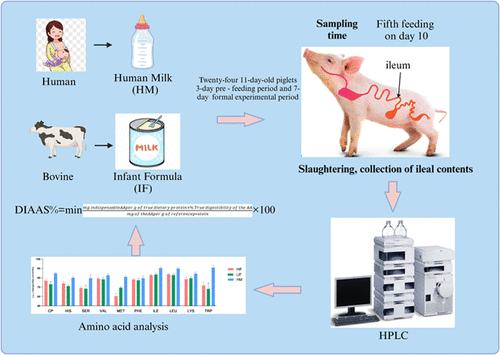婴儿配方奶粉中α-乳清蛋白与β-酪蛋白不同比例对哺乳仔猪回肠真消化率和肠道形态的影响
IF 6.2
1区 农林科学
Q1 AGRICULTURE, MULTIDISCIPLINARY
引用次数: 0
摘要
母乳(BM)是婴儿的最佳营养来源,提供高度可消化的蛋白质。相反,婴儿配方奶粉中蛋白质的消化率不同,受α-乳清蛋白(α-La)和β-酪蛋白(β-CN)等蛋白质差异的影响。本试验旨在评价新生仔猪不同α-La和β-CN含量BM和IF中氨基酸的真回肠消化率(TID)。11日龄仔猪24头(4组;6个重复/组),分别饲喂无氮日粮、α-La含量为1.74 g/100、β-CN含量为2.3 g/100的高配方奶粉(HIF);低剂量婴儿配方奶粉(含1.07 g/100 α-La和1.85 g/100 β-CN)和BM(含1.82 g/100 α-La和3.05 g/100 β-CN)在预饲3天后饲喂7 d。IF的氮、丝氨酸、苏氨酸和脯氨酸浓度高于BM。氨基酸中谷氨酸含量最多,氨基酸中蛋氨酸含量最少,氨基酸中色氨酸含量最少。在AAs中,BM的TID最高,LIF最低。HIF组对AAs,特别是色氨酸的TID与BM相似,明显优于LIF组。综上所述,调节中粮中α-La和β-CN的比例可以提高AA消化率,接近BM水平。本文章由计算机程序翻译,如有差异,请以英文原文为准。

Effect of Different Ratios of α-Lactalbumin to β-Casein in Infant Formula on True Ileal Digestibility and Intestinal Morphology of Suckling Piglets
Breast milk (BM) is the optimal nutrition source for infants, providing highly digestible proteins. In contrast, the digestibility of proteins in infant formula (IF) varies, influenced by differences in proteins such as α-lactalbumin (α-La) and β-casein (β-CN). This study aimed to evaluate the true ileal digestibility (TID) of amino acids (AAs) in BM and IF with varying α-La and β-CN contents using neonatal piglets. Twenty-four 11-day-old piglets (4 groups; 6 replicates/group) received either a nitrogen-free diet, IF (high infant formula (HIF) with 1.74 g/100 α-La and 2.3 g/100 β-CN; low infant formula (LIF) with 1.07 g/100 α-La and 1.85 g/100 β-CN), or BM (1.82 g/100 α-La and 3.05 g/100 β-CN) for 7 days after 3 prefeed days. IF had higher concentrations of nitrogen, serine, threonine, and proline than BM. Glutamic acid was the most abundant AA in IF and BM, while methionine in BM and LIF or tryptophan in HIF was the least. BM showed the highest TID of AAs, with the LIF had the lowest. The HIF group’s TID for AAs, especially tryptophan, was similar to BM and significantly better than LIF. These results suggest that adjusting the α-La and β-CN ratio in IF can improve AA digestibility, approaching BM levels.
求助全文
通过发布文献求助,成功后即可免费获取论文全文。
去求助
来源期刊
CiteScore
9.90
自引率
8.20%
发文量
1375
审稿时长
2.3 months
期刊介绍:
The Journal of Agricultural and Food Chemistry publishes high-quality, cutting edge original research representing complete studies and research advances dealing with the chemistry and biochemistry of agriculture and food. The Journal also encourages papers with chemistry and/or biochemistry as a major component combined with biological/sensory/nutritional/toxicological evaluation related to agriculture and/or food.

 求助内容:
求助内容: 应助结果提醒方式:
应助结果提醒方式:


